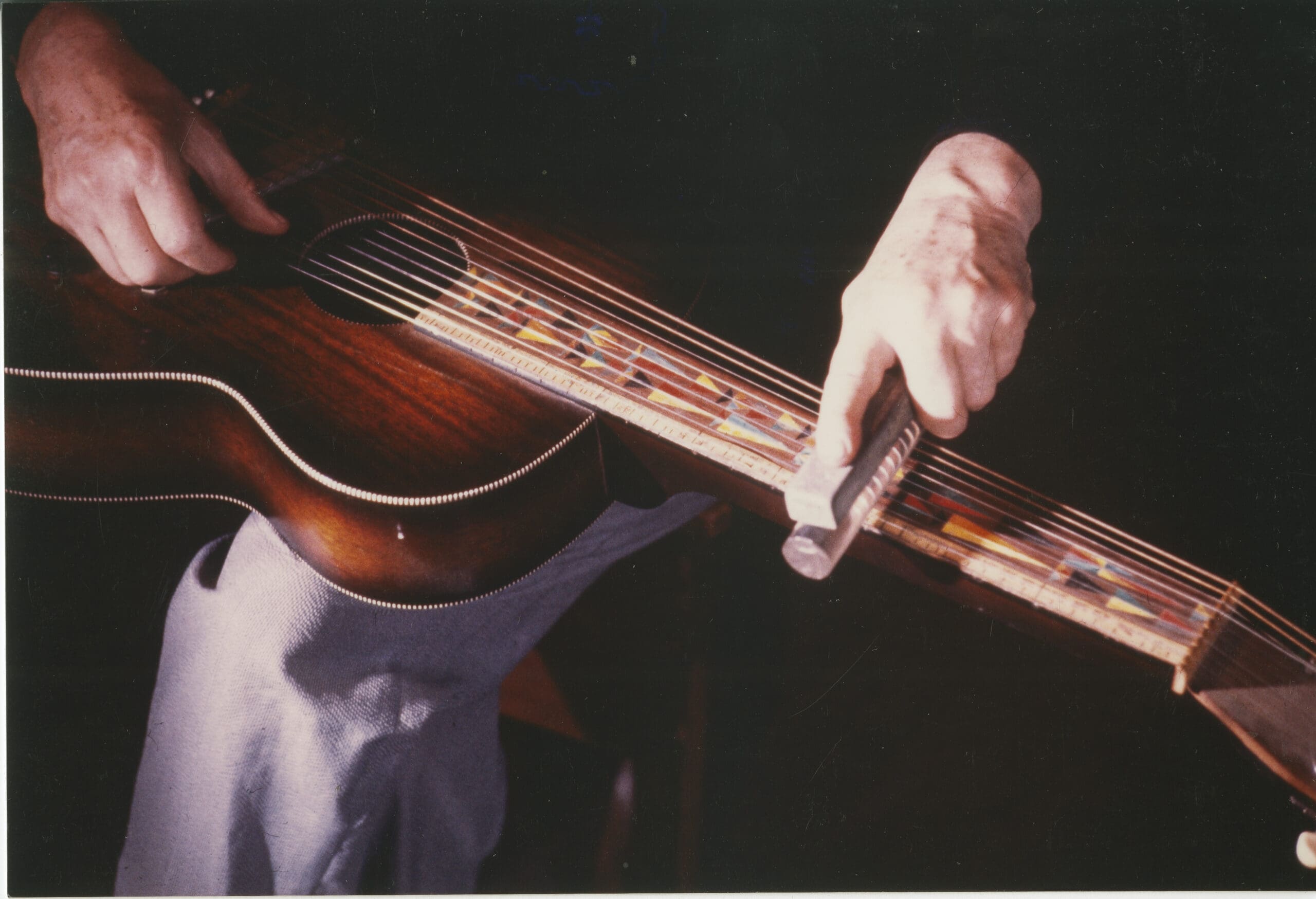In Western music, we’re accustomed to hearing music in equal temperament—an octave equally divided into twelve notes. Of course, many cultures around the world have other distinct ways of tuning that do not align with that system. Musical instruments from different cultures and genres need to be designed and built with these specific tuning conventions in mind.
One of the obvious limitations when it comes to standard guitars is that the frets are positioned to play the twelve notes of Western music. A typical guitar doesn’t allow for precise microtonal notes.
Composer and instrument maker Harry Partch found a solution. He created his own unique microtonal instruments, which utilize a tuning system known as “just intonation.”[1] Among his many creations, Partch developed a collection of modified guitars (known as adapted guitars) that were specifically designed to produce the microtonal notes he desired while retaining the familiar form and feel of a guitar. These guitars opened up fresh avenues for musicians to explore, transcending the constraints of the standard twelve-note system.
Partch first experimented with a microtonal guitar in the 1940s on a Martin 1928 Martin O-18K. Today, musicians like Chris Rainier have found inspiration in his pioneering work. As part of his extensive education and research on the composer, Rainier took on the daunting challenge of re-creating Partch’s three different versions of the adapted guitar, immersing himself in the exploration of new musical territories.

Rainier has generously shared his experiences and insights throughout the process of recreating Adapted Guitars 1, 2, and 3.
He first began the process of re-creating Partch’s guitars in 2013. Reflecting on his journey, Rainier shared, “I discovered a handful of pieces Partch had written for this guitar, and just over ten years ago I started getting access to scores through guitarist John Schneider, who was the first and previously only person with a replica of Adapted Guitar 1. John answered many, many annoying emails from me over the years during the process of researching and building the guitar. I have made replicas of other of Partch’s guitars, but the first adapted guitar is the one I have enjoyed playing the most.”
Rainier’s replica of Partch’s very first Adapted Guitar 1 was a Japanese-made 1977 Takamine F-340, designed to resemble a Martin D-28. In order to transform this guitar into Adapted Guitar 1, Partch originally made several modifications between 1934 and 1942. He added extra frets and replaced the original instrument’s low wire-style frets with high stainless-steel ones. These new frets were inserted into slots in a brass plate, which was then attached to the neck. The six strings of this guitar are arranged in three pairs of octaves, with the notes tuned from low to high being Eb, G, and B.[2]

The Adapted Guitar 2, built in 2017, is an acoustic lap steel guitar designed for Hawaiian-style playing. It features ten strings and utilizes a brass rod, later replaced with Pyrex, to allow smooth gliding pitches. Partch’s version was a six-string Regal Oahu model which he modified by adding four additional strings. The tuning of the guitar was adjusted as needed to play different pieces. For practical reasons, there are a few differences that Rainier made from the original model including narrower string spacing, a slightly different visual approach to mapping out the pitches on its fretboard, and instead of adding four strings, Rainier removed two strings from a 12-string 1976 Takamine F-400.

Partch’s Adapted Guitar 3 involved transforming his very first instrument. In 1950, he made significant changes to his original acoustic Adapted Guitar 1. He removed the frets, applied bold colors to the fingerboard, and converted it into a lap steel guitar, which he then named Adapted Guitar 3. Additionally, all of the strings on this instrument were tuned to octaves of G. Rainier created his replica in 2017 utilizing a few changes for practical reasons. He used a 1981 Takamine F-340 model, basically a copy of a Martin D-28.

Motivated by his passion for Partch’s music, Rainier embarked on a quest to learn and play Partch’s compositions on the replicas. Through practicing Partch’s music and experimenting with improvisation and new techniques, Rainier developed his own style of playing. He combined his passion for irregular tunings on regular guitars with the exploration of partial capos during the early stages of the pandemic, enabling him to access harmonies that were previously challenging to execute on a guitar. As he delved deeper into the music, Rainier discovered a world of possibilities beyond Partch’s pieces. “I started learning to play Partch’s pieces, and over time I discovered there was a lot of potential for other things,” he says. Inspired by this revelation, Rainier recently released an album titled, Sorrowful Songs of the Silverswords. It’s a showcase of semi-composed and improvised pieces, all performed on Rainier’s replica of Adapted Guitar 1.

Find it on Rainier’s Bandcamp website here. He’s also on Instagram. Learn more about the guitars here.
Above photo of Rainier in performance courtesy Patrick Van Vlerken
[1] Just intonation is the practice of tuning using whole number frequency ratios, and focuses on creating intervals using simple ratios, such as 2:1 for an octave or 3:2 for a perfect fifth.
[2] While not precisely tuned to Eb, G, and B, these notes represent the closest approximation of Adapted Guitar 1’s tuning within the framework of Western music’s 12-tone system.

Below: Partch with his Acoustic Guitar 2. Harry Partch Estate Archive
